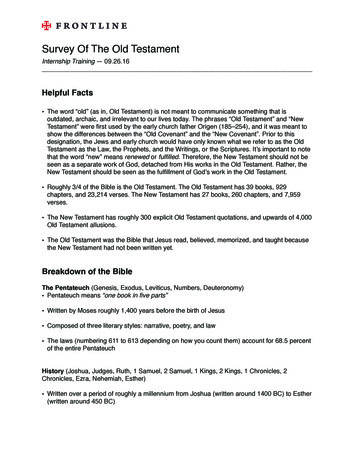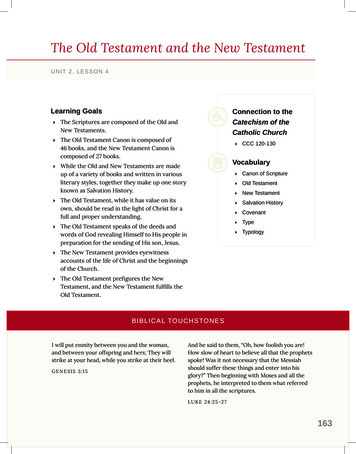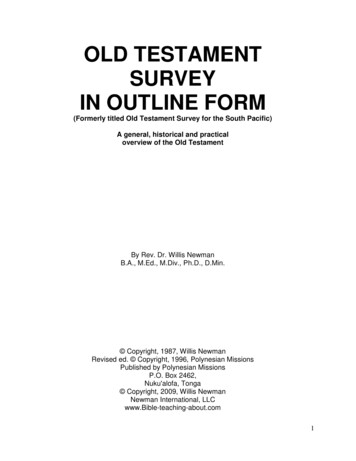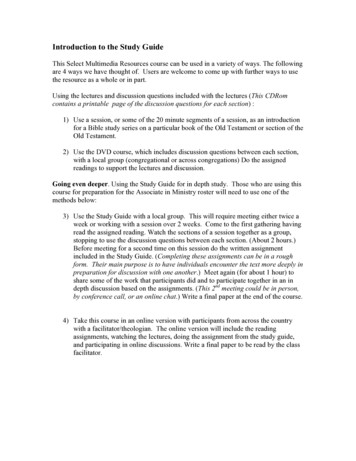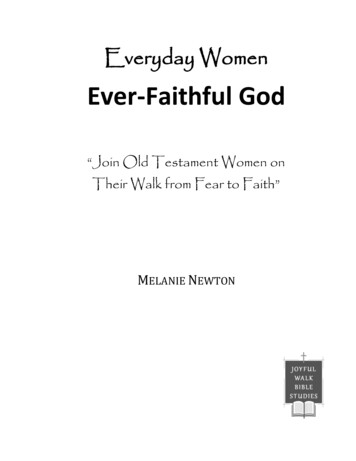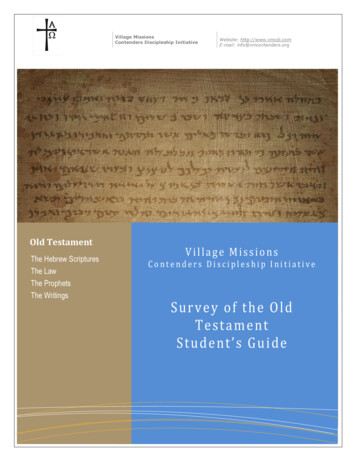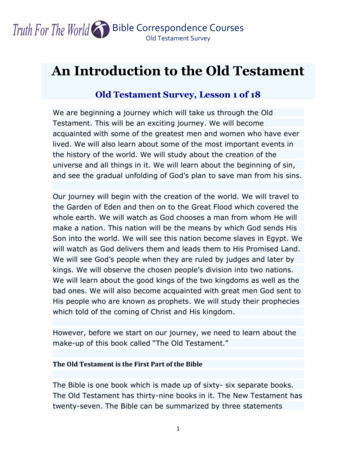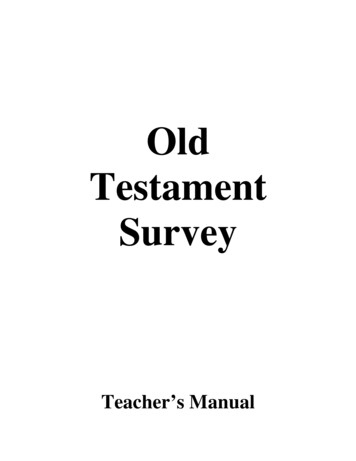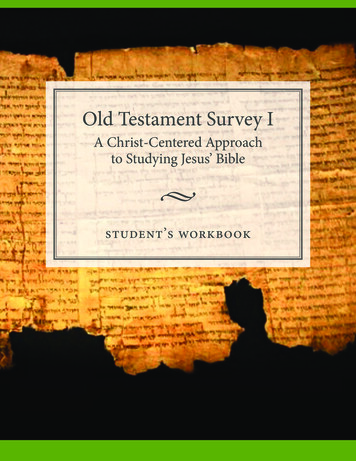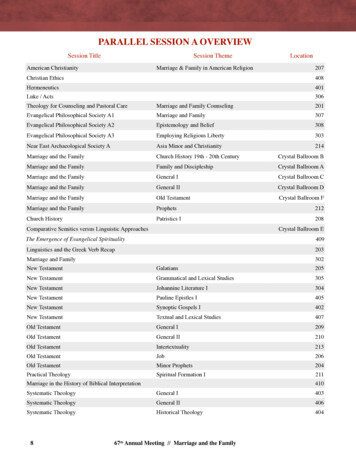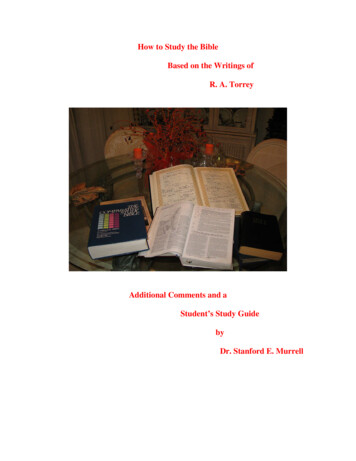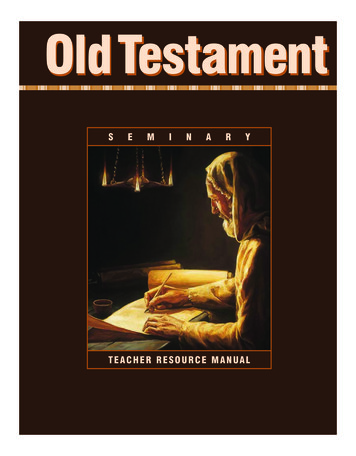
Transcription
OldTestamentOld TestamentSEMINARYT E A C H E R R E S O U R C E M A N UA L
Old Testament Teacher Resource ManualPrepared by theChurch Educational SystemPublished byThe Church of Jesus Christ of Latter-day SaintsSalt Lake City, Utah
Send comments and corrections, including typographic errors, to CES Editing, 50 E. North Temple Street,Floor 8, Salt Lake City, UT 84150-2722 USA. E-mail: ces-manuals@ldschurch.org 1998, 2003 by Intellectual Reserve, Inc.All rights reservedPrinted in the United States of AmericaEnglish approval: 10/02
CONTENTSThe First Book of the Kings . . . . . . . . . . . . . . . . . . . . . . . . . . . . 1321 Kings 1–10 . . . . . . . . . . . . . . . . . . . . . . . . . . . . . . . . . . . . . . . . . . 1321 Kings 11–16 . . . . . . . . . . . . . . . . . . . . . . . . . . . . . . . . . . . . . . . . . 1331 Kings 17–22 . . . . . . . . . . . . . . . . . . . . . . . . . . . . . . . . . . . . . . . . . 134Introduction to the Old Testament Teacher Resource Manual . . . . 1Pacing Your Teaching of the Old Testament . . . . . . . . . . . . . . . . 5An Introduction to the Old Testament . . . . . . . . . . . . . . . . . . . . . 7The Second Book of the Kings . . . . . . . . . . . . . . . . . . . . . . . . . 1372 Kings 1–13 . . . . . . . . . . . . . . . . . . . . . . . . . . . . . . . . . . . . . . . . . . 1372 Kings 14–25 . . . . . . . . . . . . . . . . . . . . . . . . . . . . . . . . . . . . . . . . . 140Scripture Study Helps . . . . . . . . . . . . . . . . . . . . . . . . . . . . . . . . . 10The Great Plan of Happiness . . . . . . . . . . . . . . . . . . . . . . . . . . . . 13The Books of Genesis, Moses, and Abraham . . . . . . . . . . . . . . 20Abraham 3 . . . . . . . . . . . . . . . . . . . . . . . . . . . . . . . . . . . . . . . . . . . . 20Moses 1 . . . . . . . . . . . . . . . . . . . . . . . . . . . . . . . . . . . . . . . . . . . . . . . 21Genesis 1–2; Moses 2–3; Abraham 4–5 . . . . . . . . . . . . . . . . . . . . . 23Genesis 3; Moses 4 . . . . . . . . . . . . . . . . . . . . . . . . . . . . . . . . . . . . . 26Genesis 4; Moses 5 . . . . . . . . . . . . . . . . . . . . . . . . . . . . . . . . . . . . . 30Genesis 5; Moses 6–7 . . . . . . . . . . . . . . . . . . . . . . . . . . . . . . . . . . . . 33Genesis 6–10; Moses 8 . . . . . . . . . . . . . . . . . . . . . . . . . . . . . . . . . . . 37Genesis 11–17; Abraham 1–2 . . . . . . . . . . . . . . . . . . . . . . . . . . . . . 40Genesis 18–23 . . . . . . . . . . . . . . . . . . . . . . . . . . . . . . . . . . . . . . . . . . 45Genesis 24–33 . . . . . . . . . . . . . . . . . . . . . . . . . . . . . . . . . . . . . . . . . . 49Genesis 34–41 . . . . . . . . . . . . . . . . . . . . . . . . . . . . . . . . . . . . . . . . . . 53Genesis 42–50 . . . . . . . . . . . . . . . . . . . . . . . . . . . . . . . . . . . . . . . . . . 58The First Book of the Chronicles . . . . . . . . . . . . . . . . . . . . . . . 1441 Chronicles 1–29 . . . . . . . . . . . . . . . . . . . . . . . . . . . . . . . . . . . . . . 144The Book of Exodus . . . . . . . . . . . . . . . . . . . . . . . . . . . . . . . . . . . 64Exodus 1–4 . . . . . . . . . . . . . . . . . . . . . . . . . . . . . . . . . . . . . . . . . . . . 64Exodus 5–10 . . . . . . . . . . . . . . . . . . . . . . . . . . . . . . . . . . . . . . . . . . . 68Exodus 11–13 . . . . . . . . . . . . . . . . . . . . . . . . . . . . . . . . . . . . . . . . . . 71Exodus 14–15 . . . . . . . . . . . . . . . . . . . . . . . . . . . . . . . . . . . . . . . . . . 73Exodus 16–17 . . . . . . . . . . . . . . . . . . . . . . . . . . . . . . . . . . . . . . . . . . 75Exodus 18–24 . . . . . . . . . . . . . . . . . . . . . . . . . . . . . . . . . . . . . . . . . . 77Exodus 25–40 . . . . . . . . . . . . . . . . . . . . . . . . . . . . . . . . . . . . . . . . . . 81The Book of Job . . . . . . . . . . . . . . . . . . . . . . . . . . . . . . . . . . . . . . 153Job 1–42 . . . . . . . . . . . . . . . . . . . . . . . . . . . . . . . . . . . . . . . . . . . . . . 153The Second Book of the Chronicles . . . . . . . . . . . . . . . . . . . . . 1462 Chronicles 1–36 . . . . . . . . . . . . . . . . . . . . . . . . . . . . . . . . . . . . . . 146The Book of Ezra . . . . . . . . . . . . . . . . . . . . . . . . . . . . . . . . . . . . . 147Ezra 1–10 . . . . . . . . . . . . . . . . . . . . . . . . . . . . . . . . . . . . . . . . . . . . 147The Book of Nehemiah . . . . . . . . . . . . . . . . . . . . . . . . . . . . . . . . 149Nehemiah 1–13 . . . . . . . . . . . . . . . . . . . . . . . . . . . . . . . . . . . . . . . 149The Book of Esther . . . . . . . . . . . . . . . . . . . . . . . . . . . . . . . . . . . 151Esther 1–10 . . . . . . . . . . . . . . . . . . . . . . . . . . . . . . . . . . . . . . . . . . . 151The Book of Psalms . . . . . . . . . . . . . . . . . . . . . . . . . . . . . . . . . . 156Psalms 1–150 . . . . . . . . . . . . . . . . . . . . . . . . . . . . . . . . . . . . . . . . . 156The Proverbs . . . . . . . . . . . . . . . . . . . . . . . . . . . . . . . . . . . . . . . . 160Proverbs 1–31 . . . . . . . . . . . . . . . . . . . . . . . . . . . . . . . . . . . . . . . . . 160Ecclesiastes or, the Preacher . . . . . . . . . . . . . . . . . . . . . . . . . . . . 162Ecclesiastes 1–12 . . . . . . . . . . . . . . . . . . . . . . . . . . . . . . . . . . . . . . 162The Book of Leviticus . . . . . . . . . . . . . . . . . . . . . . . . . . . . . . . . . . 87Leviticus 1–16 . . . . . . . . . . . . . . . . . . . . . . . . . . . . . . . . . . . . . . . . . 87Leviticus 17–27 . . . . . . . . . . . . . . . . . . . . . . . . . . . . . . . . . . . . . . . . 91The Song of Solomon . . . . . . . . . . . . . . . . . . . . . . . . . . . . . . . . . 163The Book of Isaiah . . . . . . . . . . . . . . . . . . . . . . . . . . . . . . . . . . . 164Isaiah 1–12 . . . . . . . . . . . . . . . . . . . . . . . . . . . . . . . . . . . . . . . . . . . 164Isaiah 13–23 . . . . . . . . . . . . . . . . . . . . . . . . . . . . . . . . . . . . . . . . . . 168Isaiah 24–35 . . . . . . . . . . . . . . . . . . . . . . . . . . . . . . . . . . . . . . . . . . 169Isaiah 36–39 . . . . . . . . . . . . . . . . . . . . . . . . . . . . . . . . . . . . . . . . . . 171Isaiah 40–47 . . . . . . . . . . . . . . . . . . . . . . . . . . . . . . . . . . . . . . . . . . 171Isaiah 48–66 . . . . . . . . . . . . . . . . . . . . . . . . . . . . . . . . . . . . . . . . . . 172The Book of Numbers . . . . . . . . . . . . . . . . . . . . . . . . . . . . . . . . . 94Numbers 1–10 . . . . . . . . . . . . . . . . . . . . . . . . . . . . . . . . . . . . . . . . . 94Numbers 11–21 . . . . . . . . . . . . . . . . . . . . . . . . . . . . . . . . . . . . . . . . 96Numbers 22–36 . . . . . . . . . . . . . . . . . . . . . . . . . . . . . . . . . . . . . . . . 99The Book of Deuteronomy . . . . . . . . . . . . . . . . . . . . . . . . . . . . . 102Deuteronomy 1–34 . . . . . . . . . . . . . . . . . . . . . . . . . . . . . . . . . . . . 102The Book of Judges . . . . . . . . . . . . . . . . . . . . . . . . . . . . . . . . . . . 112Judges 1–21 . . . . . . . . . . . . . . . . . . . . . . . . . . . . . . . . . . . . . . . . . . . 112The Book of Jeremiah . . . . . . . . . . . . . . . . . . . . . . . . . . . . . . . . . 177Jeremiah 1–19 . . . . . . . . . . . . . . . . . . . . . . . . . . . . . . . . . . . . . . . . . 177Jeremiah 20–29 . . . . . . . . . . . . . . . . . . . . . . . . . . . . . . . . . . . . . . . . 180Jeremiah 30–33 . . . . . . . . . . . . . . . . . . . . . . . . . . . . . . . . . . . . . . . . 181Jeremiah 34–52 . . . . . . . . . . . . . . . . . . . . . . . . . . . . . . . . . . . . . . . . 183The Book of Ruth . . . . . . . . . . . . . . . . . . . . . . . . . . . . . . . . . . . . 117Ruth 1–4 . . . . . . . . . . . . . . . . . . . . . . . . . . . . . . . . . . . . . . . . . . . . . 117The Lamentations of Jeremiah . . . . . . . . . . . . . . . . . . . . . . . . . 185Lamentations 1–5 . . . . . . . . . . . . . . . . . . . . . . . . . . . . . . . . . . . . . 185The First Book of Samuel . . . . . . . . . . . . . . . . . . . . . . . . . . . . . . 1191 Samuel 1–11 . . . . . . . . . . . . . . . . . . . . . . . . . . . . . . . . . . . . . . . . . 1191 Samuel 12–15 . . . . . . . . . . . . . . . . . . . . . . . . . . . . . . . . . . . . . . . 1221 Samuel 16–17 . . . . . . . . . . . . . . . . . . . . . . . . . . . . . . . . . . . . . . . 1231 Samuel 18–31 . . . . . . . . . . . . . . . . . . . . . . . . . . . . . . . . . . . . . . . 125The Book of Ezekiel . . . . . . . . . . . . . . . . . . . . . . . . . . . . . . . . . . 186Ezekiel 1–3 . . . . . . . . . . . . . . . . . . . . . . . . . . . . . . . . . . . . . . . . . . . 186Ezekiel 4–32 . . . . . . . . . . . . . . . . . . . . . . . . . . . . . . . . . . . . . . . . . . 187Ezekiel 33–48 . . . . . . . . . . . . . . . . . . . . . . . . . . . . . . . . . . . . . . . . . 188The Book of Joshua . . . . . . . . . . . . . . . . . . . . . . . . . . . . . . . . . . . 107Joshua 1–24 . . . . . . . . . . . . . . . . . . . . . . . . . . . . . . . . . . . . . . . . . . . 107The Book of Daniel . . . . . . . . . . . . . . . . . . . . . . . . . . . . . . . . . . . 194Daniel 1–12 . . . . . . . . . . . . . . . . . . . . . . . . . . . . . . . . . . . . . . . . . . . 194The Second Book of Samuel . . . . . . . . . . . . . . . . . . . . . . . . . . . 1272 Samuel 1–10 . . . . . . . . . . . . . . . . . . . . . . . . . . . . . . . . . . . . . . . . 1272 Samuel 11–24 . . . . . . . . . . . . . . . . . . . . . . . . . . . . . . . . . . . . . . . . 129The Book of Hosea . . . . . . . . . . . . . . . . . . . . . . . . . . . . . . . . . . . 199Hosea 1–14 . . . . . . . . . . . . . . . . . . . . . . . . . . . . . . . . . . . . . . . . . . . 199iii
The Book of Joel . . . . . . . . . . . . . . . . . . . . . . . . . . . . . . . . . . . . . 201Joel 1–3 . . . . . . . . . . . . . . . . . . . . . . . . . . . . . . . . . . . . . . . . . . . . . . 201The Book of Haggai . . . . . . . . . . . . . . . . . . . . . . . . . . . . . . . . . . 211Haggai 1–2 . . . . . . . . . . . . . . . . . . . . . . . . . . . . . . . . . . . . . . . . . . . 211The Book of Amos . . . . . . . . . . . . . . . . . . . . . . . . . . . . . . . . . . . . 202Amos 1–9 . . . . . . . . . . . . . . . . . . . . . . . . . . . . . . . . . . . . . . . . . . . . 202The Book of Zechariah . . . . . . . . . . . . . . . . . . . . . . . . . . . . . . . . 213Zechariah 1–14 . . . . . . . . . . . . . . . . . . . . . . . . . . . . . . . . . . . . . . . . 213The Book of Obadiah . . . . . . . . . . . . . . . . . . . . . . . . . . . . . . . . . 204Obadiah 1 . . . . . . . . . . . . . . . . . . . . . . . . . . . . . . . . . . . . . . . . . . . . 204The Book of Malachi . . . . . . . . . . . . . . . . . . . . . . . . . . . . . . . . . . 215Malachi 1–4 . . . . . . . . . . . . . . . . . . . . . . . . . . . . . . . . . . . . . . . . . . 215The Book of Jonah . . . . . . . . . . . . . . . . . . . . . . . . . . . . . . . . . . . . 205Jonah 1–4 . . . . . . . . . . . . . . . . . . . . . . . . . . . . . . . . . . . . . . . . . . . . 205Appendix . . . . . . . . . . . . . . . . . . . . . . . . . . . . . . . . . . . . . . . . . . . 218Methods for Teaching the Scriptures . . . . . . . . . . . . . . . . . . . . . 218Scripture Mastery . . . . . . . . . . . . . . . . . . . . . . . . . . . . . . . . . . . . . 223Methods for Teaching Scripture Mastery . . . . . . . . . . . . . . . . . . 225Scripture Mastery Lists . . . . . . . . . . . . . . . . . . . . . . . . . . . . . . . . . 228The Known Universe . . . . . . . . . . . . . . . . . . . . . . . . . . . . . . . . . . 229The Family: A Proclamation to the World . . . . . . . . . . . . . . . . . 230The Living Christ: The Testimony of the Apostles . . . . . . . . . . 231The Kings and the Prophets of Israel and Judah . . . . . . . . . . . . 232Pictures . . . . . . . . . . . . . . . . . . . . . . . . . . . . . . . . . . . . . . . . . . . . . . 236The Book of Micah . . . . . . . . . . . . . . . . . . . . . . . . . . . . . . . . . . . 207Micah 1–7 . . . . . . . . . . . . . . . . . . . . . . . . . . . . . . . . . . . . . . . . . . . . 207The Book of Nahum . . . . . . . . . . . . . . . . . . . . . . . . . . . . . . . . . . 208Nahum 1–3 . . . . . . . . . . . . . . . . . . . . . . . . . . . . . . . . . . . . . . . . . . . 208The Book of Habakkuk . . . . . . . . . . . . . . . . . . . . . . . . . . . . . . . 209Habakkuk 1–3 . . . . . . . . . . . . . . . . . . . . . . . . . . . . . . . . . . . . . . . . 209The Book of Zephaniah . . . . . . . . . . . . . . . . . . . . . . . . . . . . . . . 210Zephaniah 1–3 . . . . . . . . . . . . . . . . . . . . . . . . . . . . . . . . . . . . . . . . 210iv
INTRODUCTION TO THE OLD TESTAMENT TEACHER RESOURCE MANUALways many of those principles might be taught to helpstudents understand them and apply them in their lives.“The objective of religious education in the ChurchEducational System is to assist the individual, the family,and priesthood leaders in accomplishing the mission of theChurch” (Teaching the Gospel: A Handbook for CES Teachers andLeaders [1994], 3). The first area of emphasis in meeting thisobjective is to teach students the gospel of Jesus Christ as it isfound in the standard works and the words of the prophets.This manual is provided to help you accomplish that—whatever your teaching experience and in whatever languageor country you teach.“The CES administration has determined that in the CESweekday setting, where more time is available for instruction,the scriptures should be taught in a sequential manner. Oneof the best ways to teach the gospel of Jesus Christ is to teachthe scriptures sequentially. Sequential scripture teaching isteaching the scriptures in the sequence they appear in thestandard works” (Teaching the Gospel: A Handbook, 20; see thatpage for more information on sequential scripture teaching).This manual follows the sequence of the scriptures as youshould teach it but does not provide teaching helps for all ofthe verses in each scripture block. Additional helps are foundin the institute student manuals and the seminary studentstudy guide.The second area of emphasis is to teach by precept andexample. Those who teach by precept and example teachthe gospel most effectively. To teach by precept you mustfirst seek, “by study and also by faith” (D&C 88:118), tounderstand the principles of the gospel of Jesus Christ. Toteach by example you must live the gospel in your personallife. Elder Boyd K. Packer, a member of the Quorum of theTwelve Apostles, taught: “Power comes when a teacher hasdone all that he can to prepare, not just the individual lesson,but in keeping his life in tune with the Spirit. If he will learnto rely on the Spirit for inspiration, he can go before hisclass . . . secure in the knowledge that he can teach withinspiration” (Teach Ye Diligently [1975], 306). The powerElder Packer spoke of is manifest as a teacher bears personaltestimony of the principle being taught.Teaching the Gospel: A Handbook for CES Teachers and Leaders(item no. 34829) gives detailed help on teaching a CES class.You should become very familiar with its contents. Thefollowing general suggestions may be helpful in your lessonpreparation.Prepare Yourself to Study and Teach the Gospel Live the gospel. Pray for the Spirit to guide you as you study, as youprepare, and as you teach.How to Use This Manual Exercise faith in the Lord, in the power of the Spirit, andin the power of the scriptures to meet the needs of yourstudents.The scriptures are to be your primary source as you prepareyour lessons. To help you with your scripture study and inpreparing your lessons, you should have the followingseminary manuals:Decide What You Will Teach Old Testament Teacher Resource Manual (this manual, itemno. 34589) Decide what portion of the scriptures you want to cover inyour lesson. This manual is divided into scripture blocksthat indicate where the story line or the subject changes.There is a pacing guide on pages 5–6 that can help youdetermine how much material to cover each day or week. Old Testament Student Study Guide (the home-studyseminary student manual, item no. 34189) Old Testament Video Guide (support materials for the videoseries, item no. 32318) Study the scripture block thoroughly. Read it several times,making note of the doctrines, principles, events, anddifficult words or phrases. This manual, the institutestudent manuals, and the student study guide will helpyou understand the scripture block and decide what isimportant for your students. You will be more effective inyour teaching if you have discovered something inspiringin the scripture block. You might then lead your studentsto make a similar discovery.You should also have the following institute student manuals: Old Testament Student Manual: Genesis–2 Samuel (religion301 [2003], item no. 32489) Old Testament Student Manual: 1 Kings–Malachi (religion 302[2003], item no. 32498) Pearl of Great Price Student Manual (religion 327, itemno. 35852) Elder Henry B. Eyring, a member of the Quorum of theTwelve Apostles, said: “I hope that you will teach thehistory and the stories in the Old Testament. I hope thatyou will teach clearly the doctrines of covenants andsacrifice which run through its pages” (Covenants andSacrifice [address to religious educators, 15 Aug. 1995], 7).Choose those doctrines, principles, and events that areThese manuals do not replace your study of the scriptures,nor do they substitute for the inspired guidance of the HolyGhost as you prepare to teach your students. They areadditional resources for your lesson preparation. In particular,the Old Testament Teacher Resource Manual provides someintroductory information to the scripture blocks, outlinessome important gospel principles to look for, and suggests1
Introduction to the Old Testament Teacher Resource Manual Quotations to display or write on the board and notes forthe students to write in their scriptures.most important for your students to know. Let thepromptings of the Spirit and the needs of your studentsguide you as you decide what to teach.Some Important Gospel Principles to Look ForNote: For helpful suggestions on what to teach, see “Decidethe What,” presentation 19 in Teaching the Gospel VideoPresentations (item no. 53953).You may find many important principles in a scripture block.This section lists some of those you might want to considerteaching to your students. The following are ways to usethem in your teaching:Decide How You Will Teach Use them as a standard to ensure that correct doctrine isbeing taught. Choose one or more teaching methods for each event,principle, or doctrine you want to teach. Use your ownmethods or those suggested in the curriculum materials. Use them to help you determine what your students needto be taught. Choose methods that encourage student readiness,participation, and application. Write them on the board to give students principles to lookfor as they study the scripture block.1. Readiness means that students are prepared spirituallyand intellectually, alert, focused, and willing toparticipate in the learning experience. “Readiness isa condition of the heart as well as the mind” (Teachingthe Gospel: A Handbook, 13). It is not a gimmick used tostart a lesson; it is a continual assessment of yourstudents’ focus. Invite students to look for additional scripture referencesthat support or explain the doctrine.Suggestions for TeachingThis section contains teaching ideas you may want toconsider as you decide how to teach the events, principles,and doctrines you have chosen from the scripture block. Youare not required to use these teaching suggestions. They areprovided as a resource for you as you consider the needs ofyour students with the direction of the Spirit. You will alsofind useful suggestions in the student study guide that couldbe adapted for use in the classroom (see “An Introduction forTeachers to the Old Testament Student Study Guide,” p. 3).2. Participation means that students are involved in thelearning process. Their participation may be physical,emotional, intellectual, and spiritual. The more involvedstudents are in the learning process, the more they willunderstand, remember, and apply.3. Application means that students accept the ideas beingtaught, understand how they can apply them to theirlives, and then seek to live according to those principles.The headings for the teaching suggestions include thefollowing:Note: For helpful suggestions on how to teach, see “Decidethe How,” presentation 20 in Teaching the Gospel VideoPresentations. See also “Methods for Teaching the Scriptures”in the appendix (pp. 218–22). Statement of Focus. Introducing each suggestion is astatement in bold type that tells the verses or chaptersand principle that particular teaching suggestion focuseson. These statements of focus often correspond to theprinciples found in the “Some Important Gospel Principlesto Look For” section of the scripture block.How This Manual Is OrganizedThe resources provided by this manual are found in thefollowing three sections. Introductory MaterialThe introductory materials for each chapter and eachscripture block provide background material and otherinformation to help you understand the scriptures in theirhistorical and scriptural setting. These, together withbackground information in the student study guide and theinstitute student manuals, can enhance your own study andunderstanding of the scriptures.Scripture Mastery. Teaching suggestions thatinclude scripture mastery passages are identifiedwith the icon shown here. President Howard W. Hunter,then President of the Quorum of the Twelve Apostles, said,“We would hope none of your students would leave yourclassroom fearful or embarrassed or ashamed that theycannot find the help they need because they do not knowthe scriptures well enough to locate the proper passages”(Eternal Investments [address to religious educators,10 Feb. 1989], 2).“Scripture mastery” is a method for teaching studentshow to find scripture verses, gain an understanding oftheir meaning, and apply them in their lives. One hundredscriptural passages—twenty-five for each scripturecourse—have been chosen to receive special emphasis inseminary. These references are labeled “Scripture Mastery”in the teaching suggestions where they are found. YouYou can also use the introductory material to provide: Motivating questions to ask your students and promotelearner readiness. Background information, things for students to look for asthey read, and other prereading helps.2
Introduction to the Old Testament Teacher Resource ManualEncourage your students to follow the assignments in the“Old Testament Reading Chart” on page 6 of the OldTestament Student Study Guide. (You may need to adapt thechart to your school year.) This will help them pace theirreading to correspond with class activities. Following thisguide, students will read about 395 pages of the OldTestament—an average of 11.3 pages per week for 35weeks.should help students master the scripture masteryreferences by reviewing them in class and encouragingstudents to learn them on their own. For suggestions onhow to encourage scripture mastery in your classes, as wellas a list of the scripture mastery references for all fourcourses of study, see “Scripture Mastery,” “Methods forTeaching Scripture Mastery,” and “Scripture Mastery Lists”in the appendix (pp. 223–28; see also Teaching the Gospel: AHandbook, pp. 34–35). Students who want to read ahead may do so, butencourage them to review the scripture block the class willbe studying during the week. Using the reading chart willchallenge you to pace yourself during the year so you canteach the entire Old Testament course.Weekly Icon. Some teaching suggestions are alsoidentified with the icon shown here. This iconidentifies teaching suggestions recommended for a teacherin a home-study program or one who wants help teachinglarger blocks of scripture.THT WS MF S Students with Special Needs. Special needs is a generalterm used to identify students of unique circumstances.It may include those with reading or learning disabilities,behavioral disorders, and intellectual disabilities. Itmay also include those who are incarcerated, attendingalternative schools, confined to wheelchairs, homebound,hearing or visually impaired, and so forth. Time Designation. At the end of the heading is anapproximate amount of time it would take to teach thatsuggestion. It is included only to help you plan your dailylessons and is not an indication of how much time shouldbe spent teaching that suggestion.The Prophet Joseph Smith said, “All the minds and spiritsthat God ever sent into the world are susceptible ofenlargement” (Teachings of the Prophet Joseph Smith, sel.Joseph Fielding Smith [1976], 354). You should make everyreasonable effort to meet the learning needs of all yourstudents. It may not be possible to meet all the needs ofall the students all the time. You can, however, be awareof the special needs of your students and adapt theregular curriculum materials so that all students can gainsomething from at least part of each lesson. Other studentscan also be given the opportunity to help students withspecial needs. Such selfless service is a blessing to both thegiver and the receiver.Other Teaching Helps Videos. The Old Testament Video (item no. 53058).contains presentations to help you teach the OldTestament. Teaching suggestions for the Old Testament Videopresentations are found in the Old Testament Video Guide(item no. 32318). The Old Testament Symposium 1995Resource Videocassette (item no. 53248) also containspresentations that you can use in your teaching. Scriptureblocks for which there is a video presentation aredesignated with the icon shown here and a note at thebeginning of the teaching suggestions section. Appendix. Occasionally a teaching suggestion refers to achart, harmony, or handout in the appendix that can helpyou teach that suggestion. These items are referred to bytitle and page number.In addition to the regular curriculum materials, othermaterials are available to help teach those with specialneeds. The Church Educational System PublicationsCatalog lists the Beginning Course, a highly visual,simplified curriculum for students on a second- to fourthgrade reading level. The catalog also includes items inbraille and on audiocassette or videocassette. (For theseand related materials, see “Specialized Curriculum” inthe subject index.) Note that all new CES videos producedfor the classroom are closed-captioned. In addition to theCES catalog, the Church Materials Catalog includesmany helpful items for students with special needs (seeespecially the “Audiocassettes”; “Disabilities, Materials forMembers with”; “Videocassettes”; and “Videocassettes,American Sign Language” sections in the subject index).The Church magazines are good sources for articles,pictures, and ideas that may relate to the special needs ofyour students. The Gospel Art Picture Kit is another sourceof pictures that may help you in your teaching. Gospel Art Picture Kit (item no. 34730). The 160 colorpictures in this package depict scripture and Churchhistory stories and illustrate gospel principles. Many of thepictures used in the teaching suggestions in this manualcome from the Gospel Art Picture Kit. The kit is availablein ward and branch libraries throughout the Church. Note:If you ordered the Gospel Art Picture Kit before 1999, youmay also need the Supplement (item no. 34740) to have all160 pictures. Student Reading of the Old Testament. Encouragestudents to read the assigned portions of the OldTestament. President Spencer W. Kimball once said: “I findthat when I get casual in my relationships with divinityand when it seems that no divine ear is listening and nodivine voice is speaking, that I am far, far away. If Iimmerse myself in the scriptures the distance narrows andthe spirituality returns” (The Teachings of Spencer W. Kimball,ed. Edward L. Kimball [1982], 135).3
Introduction to the Old Testament Teacher Resource ManualAn Introduction for Teachers to theOld Testament Student Study GuideGrading the Student NotebooksThere is no answer sheet for checking the activities in thestudent study guide. Some of the answers are found in thescriptures and should be apparent to you as you familiarizeyourself with each activity. Other answers are based on thestudents’ ideas, experiences, opinions, and testimonies. Inthese cases there may not be a single correct answer. Evaluateand grade students on the degree of effort made based ontheir abilities. As you write your comments, correct anymisunderstandings or answers that are clearly wrong, andpraise students for their effort.The Old Testament Student Study Guide helps students read theOld Testament and then ponder and apply its teachings. It isrequired for the home-study program, but most daily teacherswill also find it useful in their preparation and teaching.Use in the Home-Study Seminary ProgramSeminary is a five-day-a-week program (or its equivalent)throughout the school year. Because home-study seminaryclasses meet only once a week, home-study students shoulduse the student study guide the other four days. Although allstudents are encouraged to read the scriptures daily, homestudy students should understand that they are expected tospend 30–40 minutes a day for four school days each weekworking on the activities and assignments in the study guide.Be sensitive to students with special needs, and adapt thestudent study guide accordingly. For example, students withdisabilities that make writing difficult might be allowed touse a tape recorder to record their work or have friends orfamily members write for them. You may need to adapt thenumber of study activities assigned to some students becauseof special needs. Other students may be advanced and couldbe encouraged to go beyond the minimum requir
Old Testament Student Study Guide(the home-study seminary student manual, item no. 34189) Old Testament Video Guide(support materials for the video series, item no. 32318) You should also have the following institute student manuals: Old Testament Student Manu
